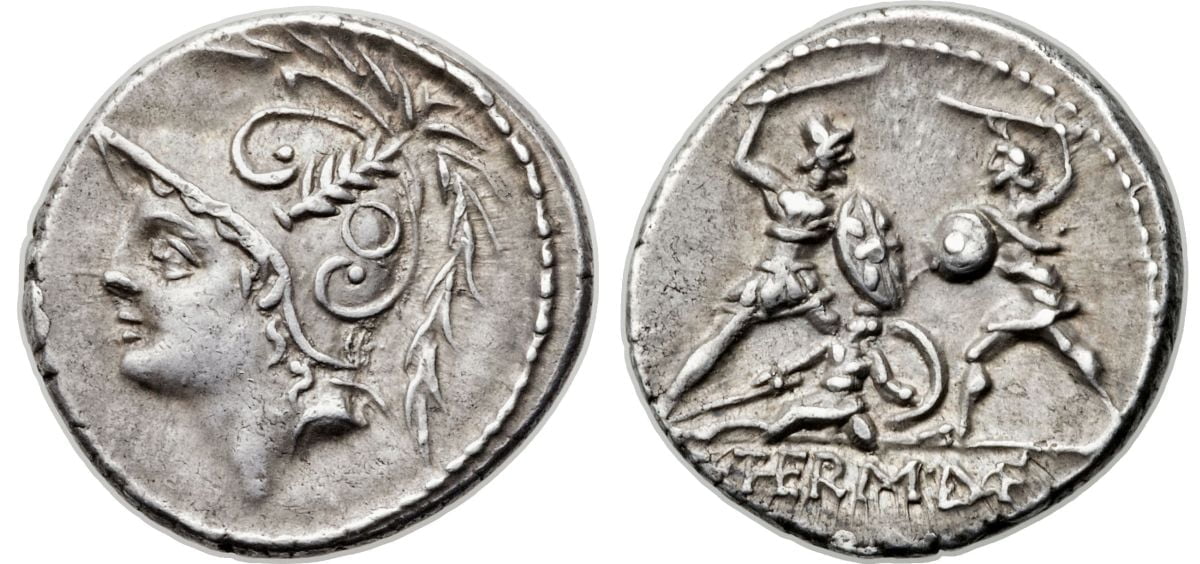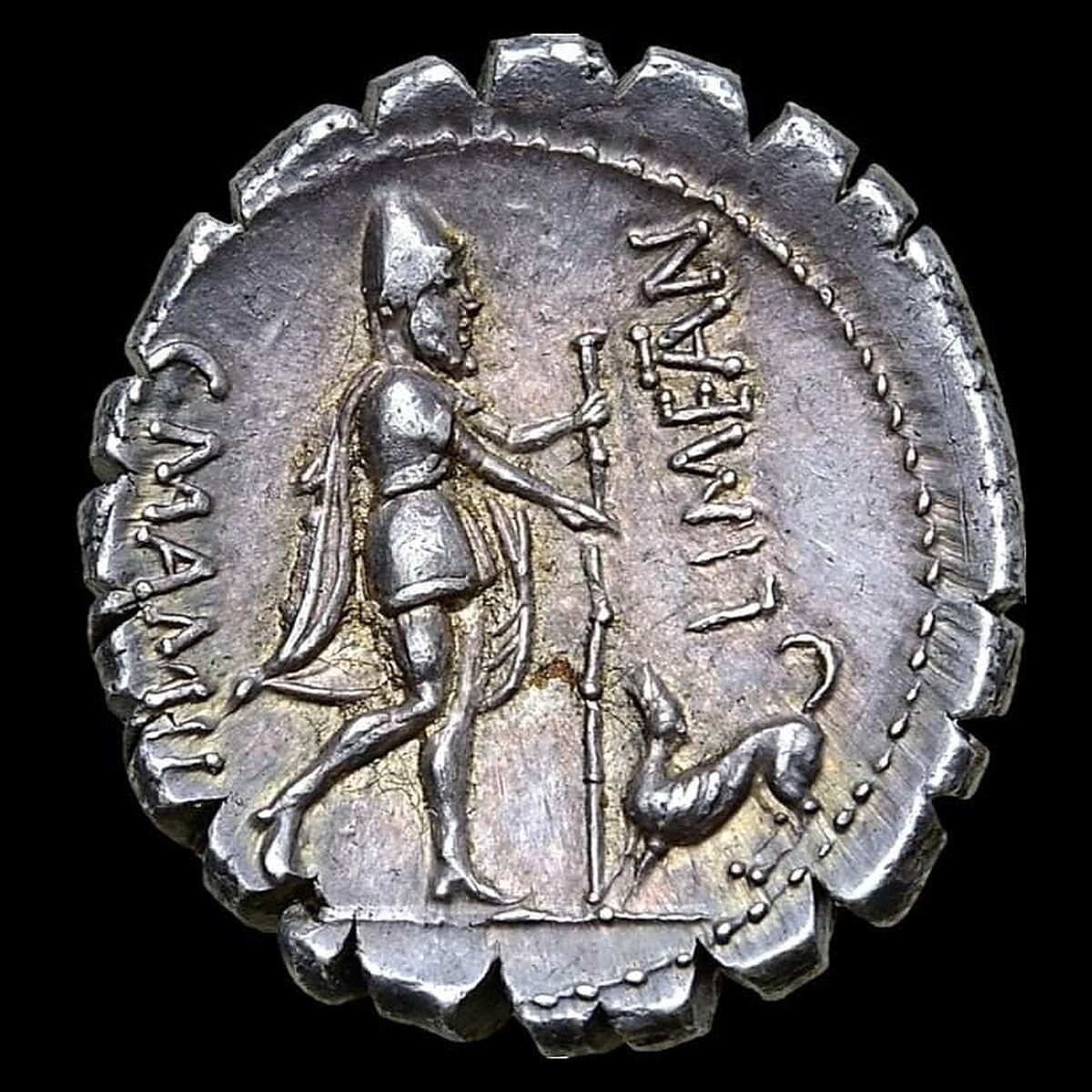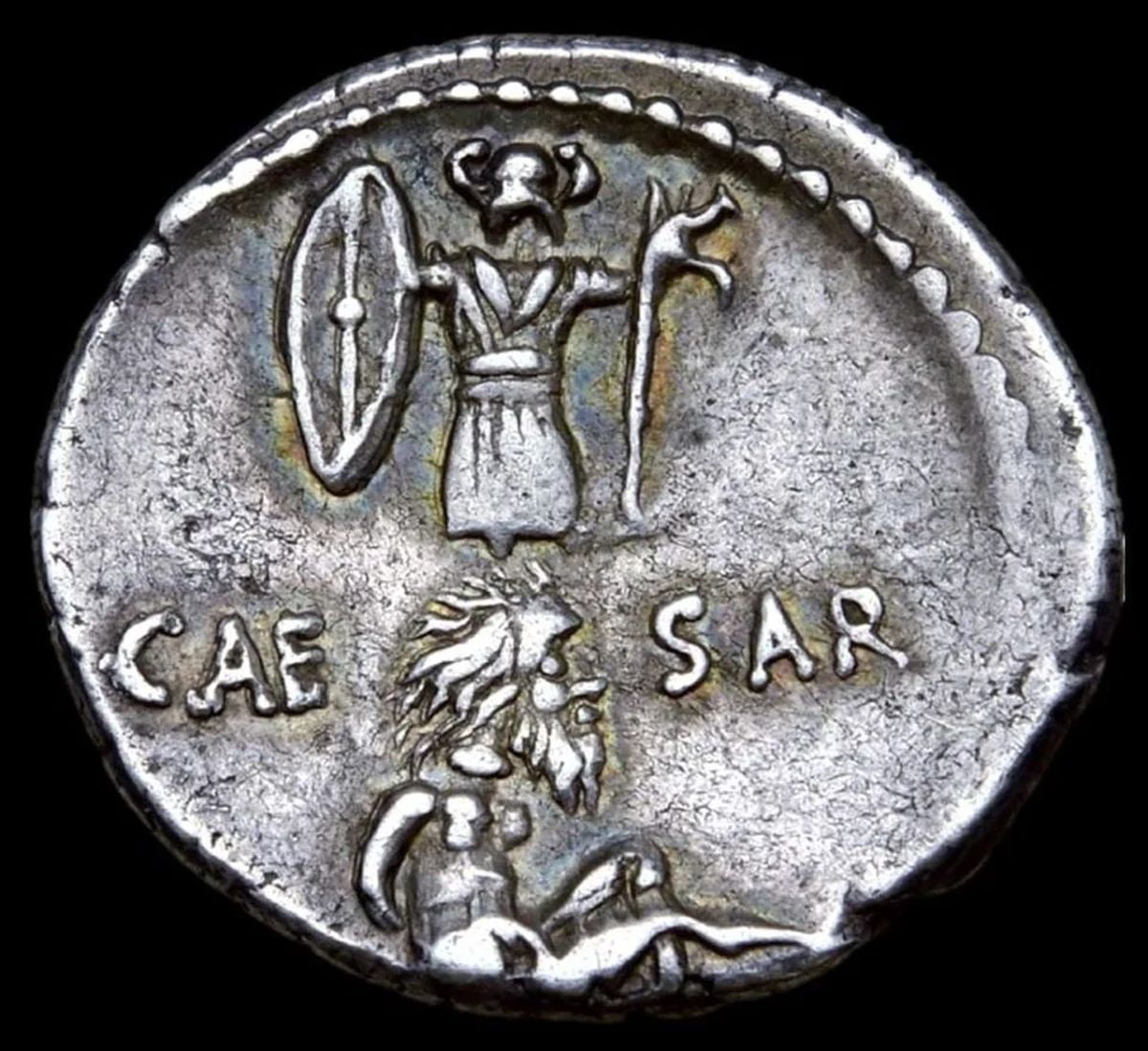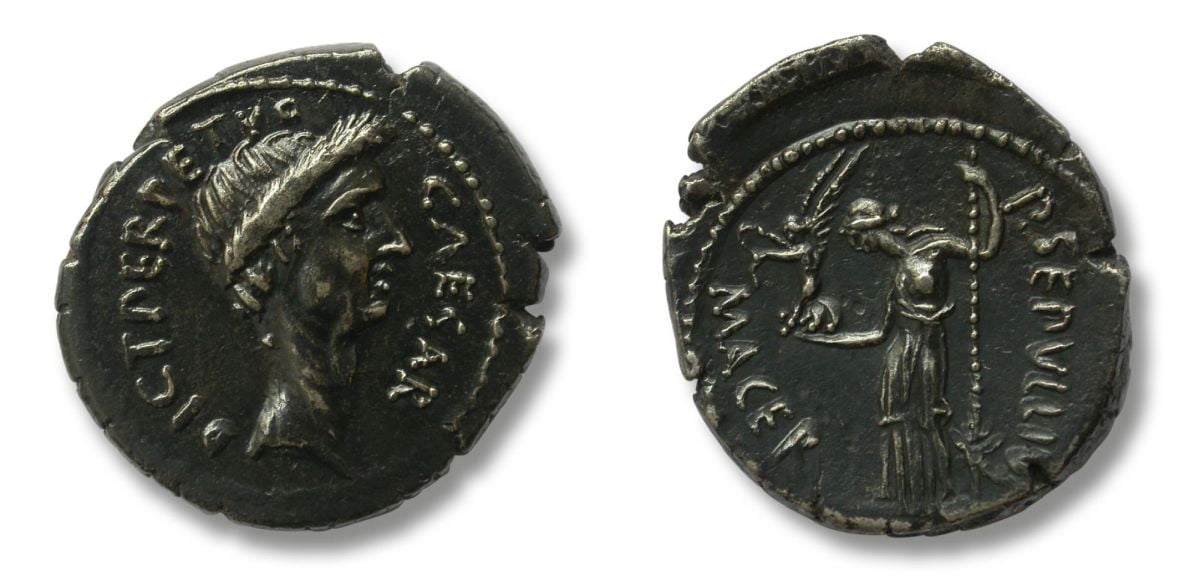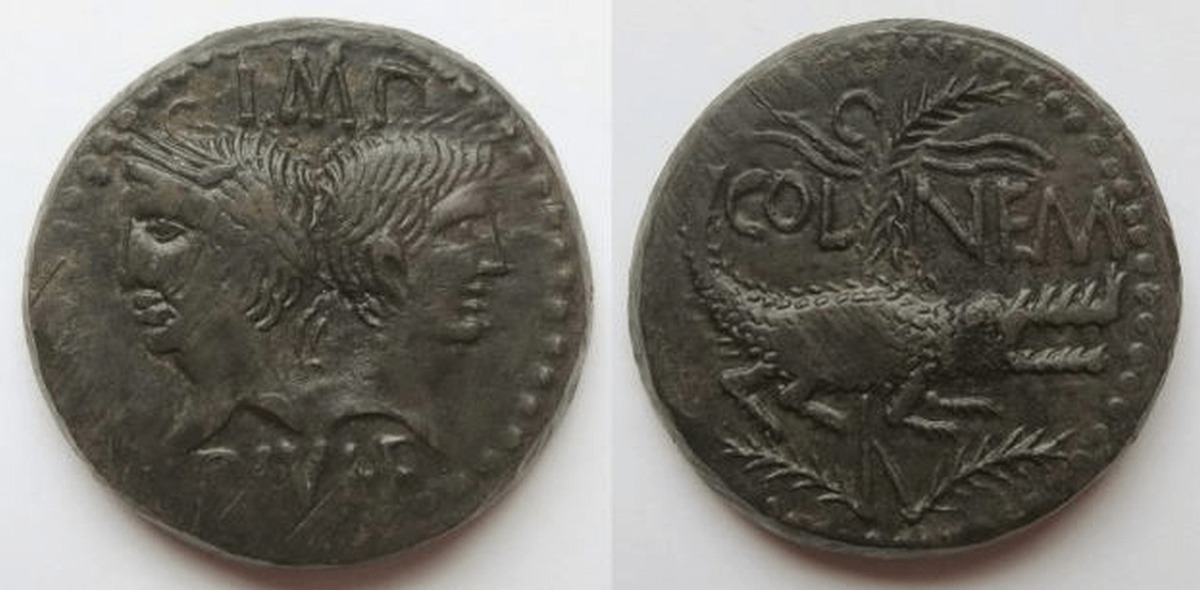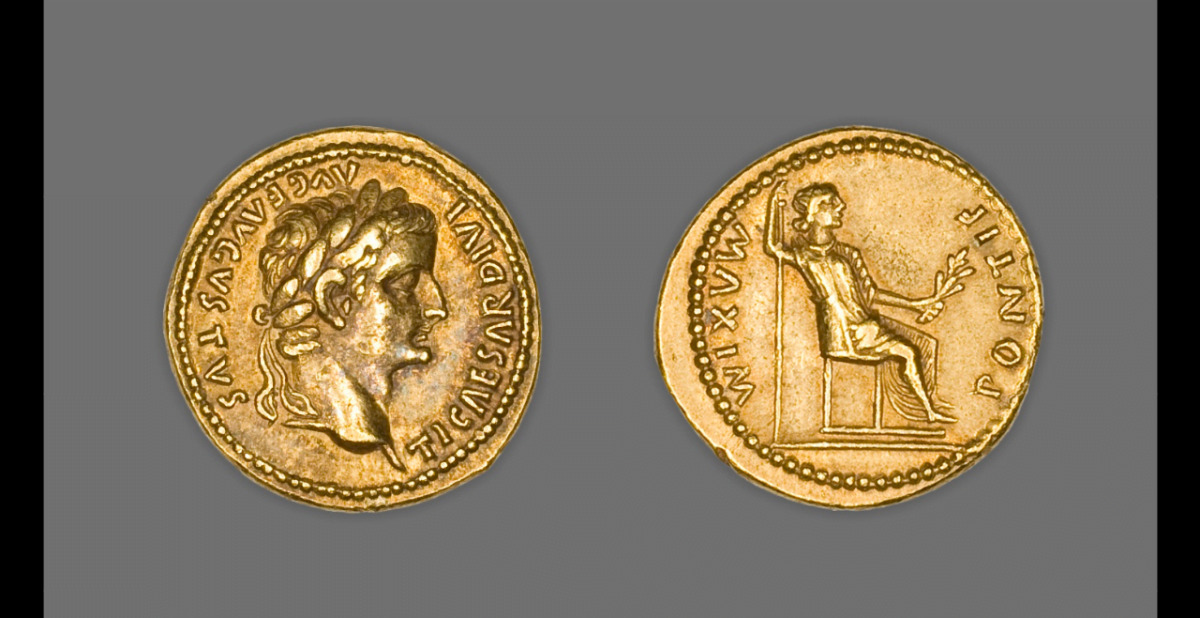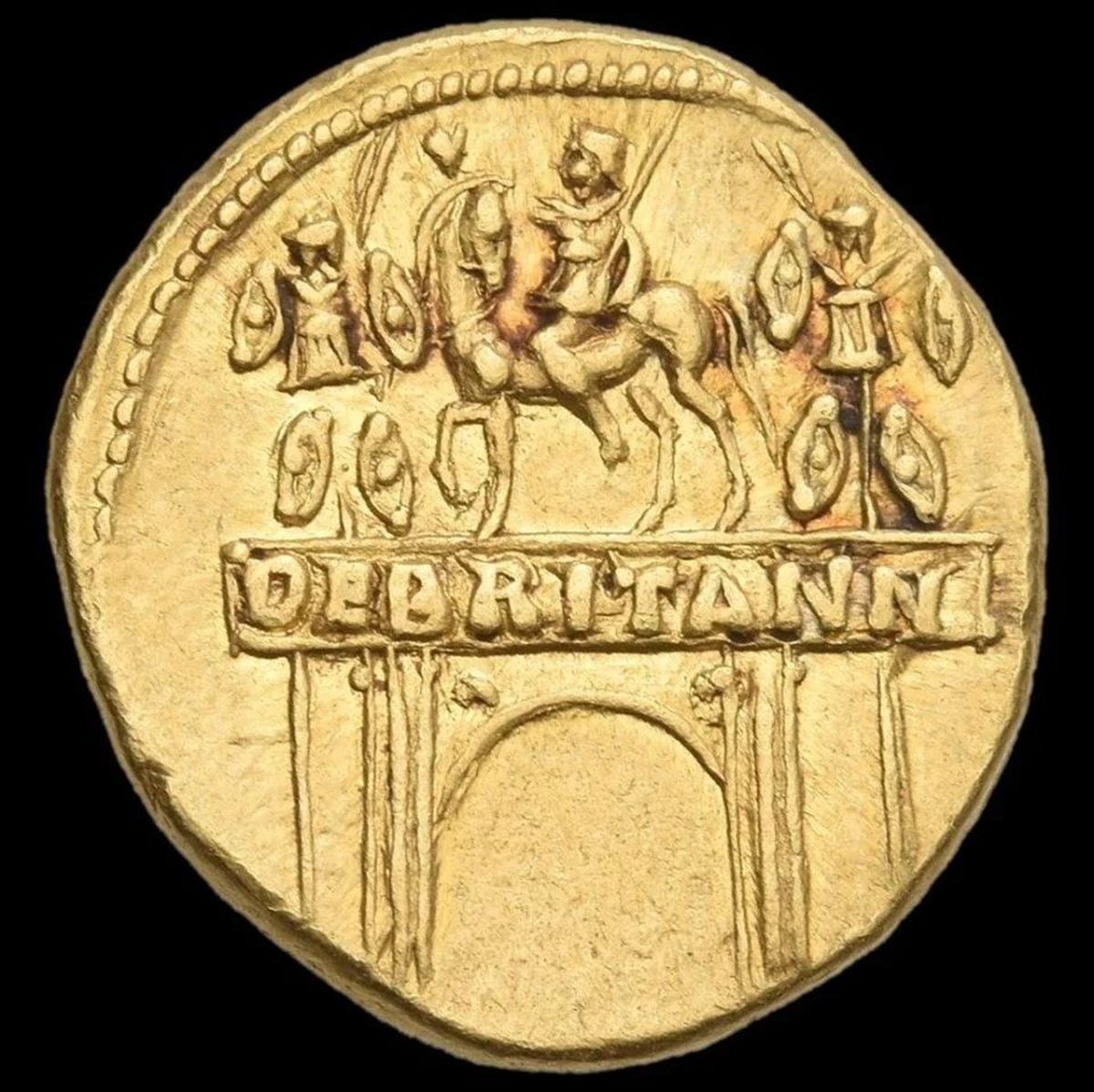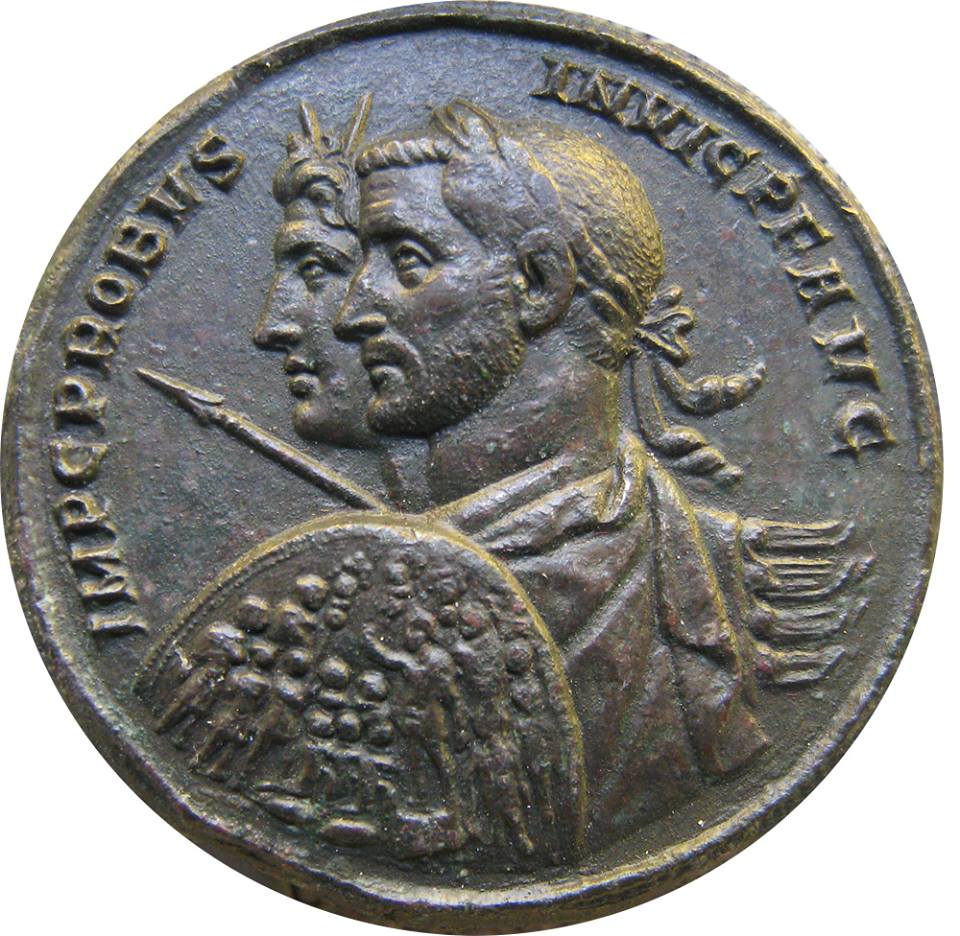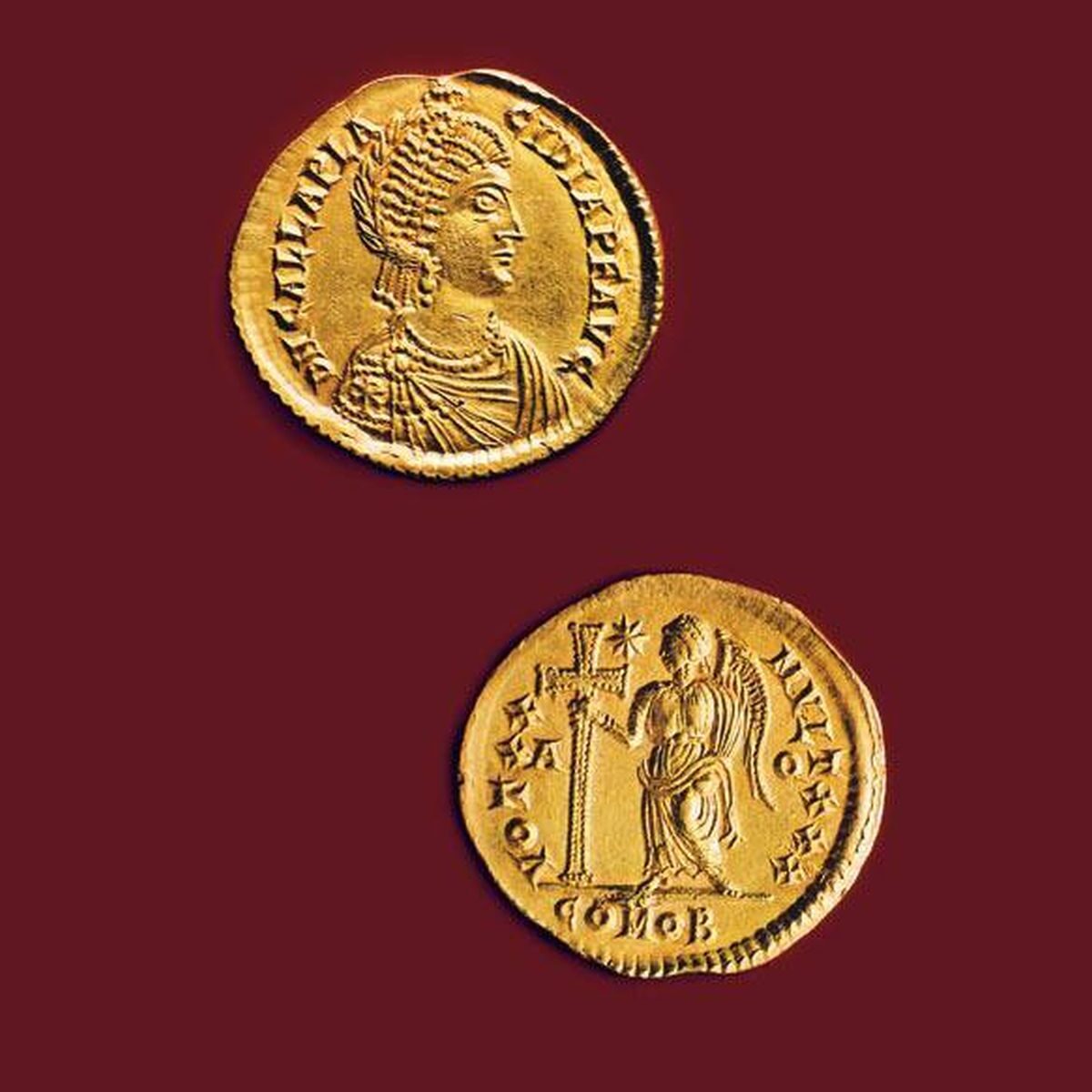Chapters
With the growth of the Roman state and the emergence of real money, the Romans began to see the importance of coins aside from the payment function. The possibility of placing initials and images/symbols on the obverse or reverse allowed politicians and emperors to influence the social masses. After all, every inhabitant of the Roman state wanted money, which was also indirectly a carrier of information and a means of propaganda.
History of Roman money
Originally, the state property of Rome was kept in the form of herds of cattle. Interestingly, theft was defined by the word peculatus, which referred to cattle and meant stealing animals.
Launch of bronze coins
With the increasing contact of the Romans with the Greeks living in southern Italy (so-called Great Greece), a need appeared in Roman society to imitate their Greek neighbours. Scientists indicate the probable time of the emergence of a new means of payment in the middle of the 5th century BCE. aes rude. Over time, rectangular, untreated bronze bars (aes signatum, or “embossed bronze”) appeared, often depicting a cattle or a branch with side branches (the so-called Ramo Secco). Probably aes signatum was used until the end of the Third Punic War, i.e. the middle of the 3rd century BCE
In the meantime, the Romans also began to make smaller bronze coins, which imitated their Greek counterparts, and which were more similar in shape to the familiar coins. These activities also had a prestigious aspect – belonging to higher civilizations. And this is how money called aes grave appeared, probably already in the 3rd century BCE
Introduction of the silver coin – didrachma
At the beginning of the 3rd century BCE, during the conflict with Pyrrhus (282-272 BCE), Rome introduced the first didrachma silver coin, which naturally it was taken from Greek cities. Their production initially took place in Campania. The coin featured the image of the god of war Mars in a Corinthian helmet and the inscription “ROMANO” – these were minted in Campania. With time, the inscription “ROMA” began to appear, which had already begun in Rome. This coin was probably created at a similar time as aes grave, but it had a typical propaganda dimension and was primarily intended to pay for soldiers taking part in the war, both their own citizens, mercenaries and Greek allies.
With time, a new image appeared on the coin – Hercules and the she-wolf with twins began to be shown. In the years 235-225 BCE, the quadrigant coin appeared, the name of which was derived from the image of Jupiter on the coin that he was driving in the quadriga.
Launch of new silver coins
Even at the beginning of the Second Punic War, the Romans relied on the didrachm for payments. However, in 212-211 BCE a new silver coin appeared – denarius (nummus denarius) – which had the equivalent of 10 aces. The huge amounts of silver obtained in Syracuse, a city in alliance with Hannibal, were used to mint the coins.
Arrival of the Roman gold coin
The first mentions of gold coins in Rome appear during the Second Punic War when coins based on Greek patterns were minted: stater and half-stater. However, due to the lack of a constant supply of gold, the minting of coins was abandoned at a constant level.
The first mention of a new gold coin comes from the public activity of Lucius Cornelius Sulla, who was getting ready for the war with Mithridates VI. Coins were minted for the purposes of war; similarly, later Julius Caesar did before the planned expedition to the Parthia.
During the reign of Octavian Augustus, the formal minting of the gold aureus began.
The basic monetary conversion, which was used in the Roman Empire throughout the 1st and 2nd centuries CE |
|
What was put on Roman coins?
In the early days, Roman coins had images of cattle or branches. Over time, Roman deities began to appear (Jupiter, Janus, Junons, Mars or Minervas and symbols referring to the cult or traditional past of the state (e.g. the she-wolf suckling twins or the beaks of ships, which symbolized the victories of the Romans over Carthage in the Mediterranean Sea). Symbolism was primarily aimed at strengthening the Roman identity and promoting the authority and culture of the Romans in the newly conquered lands.
With the end of the republic, the images of politicians begin to appear on the coins. For example, in 54 BCE, at the request of Marcus Junius Brutus, coins were minted showing his ancestors: Lucius Junius Brutus (the first Roman consul, 509 BCE) and Gaius Servilius Ahala (the killer of Spurius Maelius who wanted to seize power in the 5th century BCE). With this action, Brutus tries to gain popularity and emphasize his origin on the political scene.
The first living man whose face was featured on a coin was Gaius Julius Caesar. It later became a tradition. The images of the rulers were on one side, while the other was intended for various types of personifications. The most common ones were: Freedom, Gentleness, Wiktoria, Roma and Joy.
Imperial coins provide material for the iconography of emperors. Single words or phrases (legends) stamped on coins often depict political slogans from a given period. The subject of inscriptions and images on coins from the end of the republic is extremely diverse. Coins were one of the means of propaganda. On their basis, information about political groups and politicians can be obtained. Moreover, they enable us to check the information provided by ancient authors.
Stamps were placed on all coins. The bronze coins had the image of Janus, usually two-headed (Janus Geminus), on one side, and a beak on the other side of the ship. On the silver coins, there were images of two-horse or four-horse.
Originally, all mintage was commissioned by the senate and marked SC (Senatus Consulta). With the advent of the principate, the rights to issue coins were distributed. Coins made of less valuable metal (bronze) were subject to the senate; they still had the inscription SC (Senatus Consulta). Silver and gold coins, on the other hand, were minted at the behest of the emperors and had the inscriptions: Imp. (Imperator); Caes (Caesar); PM (Pontifex Maximus); Cos (Consul); Tr. p. (tribunicia potestate).
In the times of Constantine the Great, scenes from private life appear more and more boldly on coins. The next changes took place at the end of the 4th century CE under Theodosius the Great, when the minting of the monogram of Christ and other Christian symbols began on coins.
Sample Roman coins
Silver Roman denarius, minted in 103 BCE The reverse of the coin shows a scene of a fight between a Roman soldier (right), protecting his companion from an attack by a barbarian warrior from the Ligurian tribe (northwest Italy).
The scene refers to the message that the 193 BCE consul himself was the heroic Roman – Quintus Minucius Thermus – who received corona civica for his act. There is an inscription: Q•THERM•MF, meaning: Quintus [Minucius]Thermus.
The obverse features an image of Mars wearing a Corinthian helmet.
Roman coin minted in honour of the Mamilius family by Gaius Mamilius Limetano. The object dates back to the beginning of the 1st century BCE. On the reverse of the coin, there is an image of Odysseus, whom the family members considered to be their former ancestors. Many Roman families acted in this way, wanting to raise their prestige and link their lineage with the great figures of mythology.
Roman denarius shows the dictator Lucius Cornelius Sulla. The object dates back to around 54 BCE, so it was made posthumously (Sulla died in 78 BCE). The artefact is in The British Museum in London.
On the other side of the coin, there is an image of Consul Quintus Pompey Rufus, Sulla’s grandson, who, by commissioning a series, wanted to remind his countrymen of his origin.
Roman denarius, minted in 48-47 BCE, commemorates the triumph of Julius Caesar in Gaul. The coin has a propaganda character, due to the fact that Caesar was already a dictator at that time.
In the lower part of the coin we can see the defeated Vercingetorix; in the upper one, a trophy made of Gallic weapons and accessories: shield, helmet and carnyx (Celtic musical instrument). The inscription: CAESAR.
was also pressed
A denarius showing Julius Caesar. The coin was minted during his lifetime, in February or March 44 BCE, Julius Caesar was the first Roman who had his image on the coin during his lifetime. In this way, he wanted to show all the inhabitants of the Roman Empire that he was the absolute ruler of Rome.
The reverse of the coin features the goddess Venus leaning on a sceptre with the little goddess of victory Victoria in her hand. It is worth mentioning that the lineage of Caesar was derived from the mythical Aeneas and the goddess Venus.
The initials are also visible on the coin: CAESAR DICT PERPETVO (“eternal dictator”), MACER (that is, Publius Sepullius Macer, the originator of the series).
Roman silver denarius depicting the divine Julius Caesar from 40 BCE The coin was minted for the bursary of Q. Voconius Vitulus. The reverse side of the coin features a cow that was a sign of food, security and wealth.
One of the most famous coins of the ancient world – Roman silver denarius Marcus Junius Brutus with the words “EID MAR” stamped on it. These words refer to the date of the murder of the dictator Julius Caesar – on the Ides of March, March 15, 44 BCE The coin was minted between 43 and 42 BCE
When the obverse of the coin features the image of Brutus, the reverse features daggers symbolizing the murder weapon and a Phrygian cap (pileus) – a symbol of freedom, which, among others, was given to a slave when his owner freed him.
Golden aureus Marcus Junius Brutus, one of the murderers of Julius Caesar. Object dated 43-42 BCE The artefact is in The British Museum.
The coin was minted during Brutus and Cassius’ stay in western Asia Minor or northern Greece and was of a propaganda character during their rivalry with Octavian, Marcus Antony and Marcus Lepidus.
Silver denarius Octavian, a kind of proof of Rome’s victory over Cleopatra and the incorporation of Egypt into the Empire in 30 BCE
The coin was probably minted in 29 BCE as part of the propaganda of the sole ruler. The reverse of the denarius shows a Nile crocodile (symbol of Egypt) with the inscription AEGVPTO CAPTA, meaning “Egypt conquered”.
Roman coin was minted in honour of the victory of Octavian Augustus over Marcus Antony and Cleopatra at the Battle of Actium in 31 BCE. Octavian and his friend and commander Marcus Agrippa are depicted on the obverse. On the reverse, there is a crocodile pinned to a palm branch, which symbolizes the joining of Egypt with Rome.
Roman denarius shows the Octavian of Augustus (ruled from 27 BCE – 14 CE). The silver coin was minted around 19-18 BCE, probably in one of the Spanish mints. On the obverse, we can see the head of a princeps with a wreath of oak leaves on the head (the so-called corna civica). On the reverse, there is an embossed inscription DIVVS IIVLIVS and a comet with eight rays and a tail of fire.
The coin has a propaganda character and refers to the divinity of Julius Caesar and the event that was to take place in July 44 BCE – four months after the murder of Caesar – during the great ceremony in memory of Caesar – Ludi Victoriae Caesaris. At that time, an extremely bright object was supposed to appear in the sky, which caught the attention of the gathered Romans. Due to the fact that Caesar considered himself (as a member of the Julius family) to be a descendant of the goddess Venus himself, and the Roman senate officially recognized Caesar as a god, the crowds, seeing the comet in the sky, recognized this as confirmation of Caesar’s divinity, and the star itself was to contain the chief’s soul.
The phenomenon naturally observed by the ancients was a falling comet, which astronomers felt could be the brightest ever observed by humans. Ancient authors referred to it as SidusIulium (“Julius Star”) or Caesaris astrum (“Caesar’s Star”).
In 44 BCE Gaius Octavian – who had no real sign yet on the Roman political scene – used this event for propaganda purposes. In 42 BCE the Temple of Caesar was built, which in 29 BCE was dedicated to the event with the comet. On the wall of the temple, there is a large image of Caesar, on whose forehead – according to Ovid (“Metamorphoses”, XV.745-842) – a comet was attached. In this way, Octavian emphasized the symbolism of the event, the divinity of Caesar and emphasized his legitimacy as the successor of the adored leader.
Octavian August’s coin, was minted after the victorious battle of Actium, was between 31-29 BCE. The coin has strong symbolism.
The obverse shows the head of Jupiter Ammon with horns, with the annotation AVGVR PONTIF. On the reverse, the inscription IMP CAESAR DIVI F (i.e. Imperator Caesari Divi Filius), with the image of Victoria standing on the globe, holding a laurel wreath in her right hand and a palm tree in her left hand.
Aureus showing Emperor Tiberius on the obverse; on the reverse, in turn, was probably his influential mother Livia, who was presented as the goddess of peace Pax. The front of the coin inscription reads TI CAESAR DIVI AVG F AVGVTVS, proclaiming “Tiberius Caesar Augustus, son of deified Augustus”; on the second PONTIF MAXIM, that is “the high priest”.
Golden aureus minted between CE 46-47 during the reign of Emperor Claudius. The coin was created in honour of the first Roman victories in Britain. This is evidenced by the visible triumphal arch, an inscription referring to Britain, the silhouette of a rider (perhaps Claudius himself) and a trophy made of the opponent’s weapons.
Claudius wanted to strengthen his power by conquering Britain, and the mintage of such coins was to help spread the word about his effective rule among the people.
Roman gold coin (aureus) showing Emperor Vespasian on one side and the Temple of Vesta with four columns and three statues on the other.
As researchers suggest, the depiction of the temple may be intended to emphasize the renovation and reconstruction of the building after the fire in Rome in December 69 CE. The coin was created in CE 73 and is in The British Museum.
Silver Emperor Trajan from CE 107-108 to celebrate the victorious Dack wars. On the reverse there is a trophy (the so-called tropajon) of victory in the form of a tree trunk decorated with captured enemy armour and weapons.
Roman coin of Cecilia Pauline, wife of Emperor Maximinus Thrax (ruled CE 235-238). The silver denarius has the inscription DIVA PAULINA, and the coin itself was minted after her death (ca. 235-236 CE). On the reverse of the coin, we see a peacock lifting the empress to heaven – a gesture of Maximine and proof of the deification of a Roman woman.
We have virtually no information about the life of the empress. Her coexistence with Maximinus was probably correct, but there is a message from Jan Zonaras (12th century Byzantine chronicler) that the empress was murdered at the behest of her husband. This statement, however, seems to be false as she was deified after her death at his behest.
The silver-plated antoninianus of Emperor Volusian from CE 251 Volusian (Gaius Vibius Afinius Gallus Veldumnianus Volusianus) was the son of Emperor Trebonian Gala, with whom he co-ruled the Roman state in 251-253 CE
Woluzjan was murdered with his father at Interamna by his soldiers who did not want to fight against the usurper Emilian.
It was essential for every ruler that the people knew who had the highest power. Hence, the first decision after seizing the throne was to order the minting of coins with his image.
Roman coin depicting Emperor Probus and the deity of Sol Invictus. This ruler was a strong leader of the Roman state at the end of the 3rd century CE
The cult of Sol Invictus was celebrated at the end of the empire (principate) and introduced by Emperor Aurelian. This was primarily to rebuild the divine majesty of the ruler on which power was to be based from now on. The country was experiencing a crisis in the 3rd century CE and a powerful grounding tool was needed.
Maxentius’ gold coin from CE 306-312 Maxentius, who was Maximian’s son, was not included in the tetrarchy system. He was given power by the praetorians.
Coins of this type were aimed at propaganda of the new ruler, who in this case placed the symbol of Rome on the obverse – a she-wolf feeding twins.
The emperor’s Roman coin Julian the Apostate, is dated to the 4th century CE On the reverse of the coin, there is an image of a bull under two stars – the symbolism is still not there until the end clear to scientists. They suggest that the author of the coin’s appearance was the emperor himself, who could refer to Mithraism by depicting the bull.
The cult of the god Mithra was extremely popular with soldiers. This deity was to kill the bull whose blood became the basis of the universe.
A gold Roman coin (solidus) depicting Elia Galla Placidia. The object dates back to the 5th century CE. The coin was minted in Aquileia (Italy) and found near Prokuplje in southeastern Serbia.
The obverse of the coin features a bust of Gallia Placidia with a pearl diadem on her head and a monogram of Christ on her arm. On the reverse, there is Wiktoria holding the cross in her hand.
The coin is a great proof that in the 5th-century Roman society was still partially following the old cults and the rulers were looking for support.



